I think of all the UK orchids, probably my favourite is the Bee. We have many sites in Kent that have Bee, but what I had not seen were some of the rarer variants of the species in the county. There was the one in Dover also this year, but for the most part, they have been regular Bee, here there and everywhere.
 So, when I saw on Twitter a picture of a var. flavescens Been from East Sussex, and just over the border, I leapt at the chance to go and find them.
So, when I saw on Twitter a picture of a var. flavescens Been from East Sussex, and just over the border, I leapt at the chance to go and find them. The reserve on which they are found is huge and other than they were somewhere in the several square miles, I had little idea where they were. Unusually, I asked at the reserve office where Bee orchids could be found, and the helpful lady pointed to a grass bank but said that the recent high tides had flooded the path leading to it. So, I stood at the top looking down the bank to where I could just make out the occasional Bee, rugular ones at that, bobbing in the breeze. I did not want to walk down, as it would have meant standing on other plants to get there, and anyway, I could not see a white/green one.
The reserve on which they are found is huge and other than they were somewhere in the several square miles, I had little idea where they were. Unusually, I asked at the reserve office where Bee orchids could be found, and the helpful lady pointed to a grass bank but said that the recent high tides had flooded the path leading to it. So, I stood at the top looking down the bank to where I could just make out the occasional Bee, rugular ones at that, bobbing in the breeze. I did not want to walk down, as it would have meant standing on other plants to get there, and anyway, I could not see a white/green one.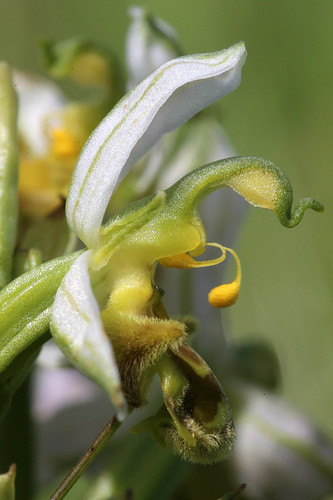 Jools went for a walk, and in a few minutes saying she thought she had found some white Bees. Did I want her to show me?
Jools went for a walk, and in a few minutes saying she thought she had found some white Bees. Did I want her to show me?Yes.
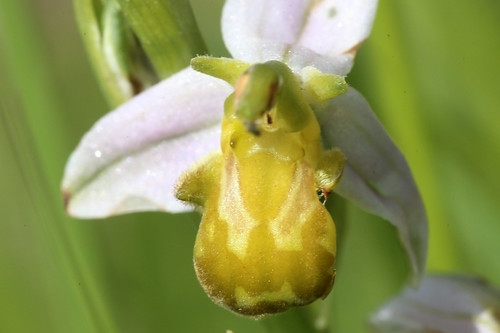 So, along the path and down on the seaward facing bank, dozens of green Bees with white sepals were bobbing in the breeze.
So, along the path and down on the seaward facing bank, dozens of green Bees with white sepals were bobbing in the breeze.In the strong breeze, I could get near to many fantastic spikes, and was in orchid heaven. And on the other side of the path, in the lea of the bank, were even more, and these not being blown about by the breeze.
So, hundreds and hundreds of this rare and hard to find var. in the same place, far more common here than the regular everyday Bee.
So.
The next few species were shot over two days on a quick trip to Norfolk to visit a usually out of bounds reserve on the Norfolk Broads, I won't name here. But on the way I had gotten information of another var. flavecens Bee, this one beside the road beside a busy main road. But before then I would call in at a meadow in Suffolk to find the Suffolk Frogs.
 This is the third or fourth year I have visited this site, so know where the tiny orchids are, and require just a few minutes to get my eye in, and there beneath my feet were the small spikes, though, in the end, one was well over a foot tall.
This is the third or fourth year I have visited this site, so know where the tiny orchids are, and require just a few minutes to get my eye in, and there beneath my feet were the small spikes, though, in the end, one was well over a foot tall.I drive up to Diss, then to Harleston, taking the road back into Suffolk, to Metfield, cruising along sunlit winding lanes, through the village and out the other side until I come to the dead end lane.
Parking up I grab the camera, walk through the memorial wood, enter the meadow through the new stile, very welcome not to have to climb over the gate, and into the meadow.
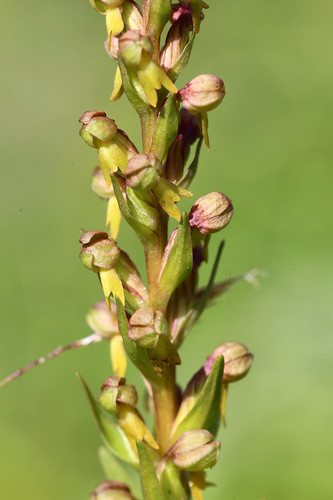 I was here to look for Frog Orchids, and having seen them three years in a row, I went to where I hoped to find them, and began looking. And looked.
I was here to look for Frog Orchids, and having seen them three years in a row, I went to where I hoped to find them, and began looking. And looked.I walked up and down the path, until I was at the point I was going to give up when I saw the spike next to my foot, growing in the path.
 I take shots of that, then see another in long grass on one side. Then another on the other side.
I take shots of that, then see another in long grass on one side. Then another on the other side.And on the main path, I find the largest spike I have seen of a Frog.
I take shots of that too.
I walk round the outside of the meadow, but fail to find a single Southern Marsh at all, and there was a reduction in numbers of Pyramidal, although I did find a pure var. alba hidden in the long grass.
As I neared Mum's, a short diversion took me to a traffic island just off the main road, where I had been told of a rare Bee Orchid, a pales, more unusual one than the colony seen in Sussex last week.
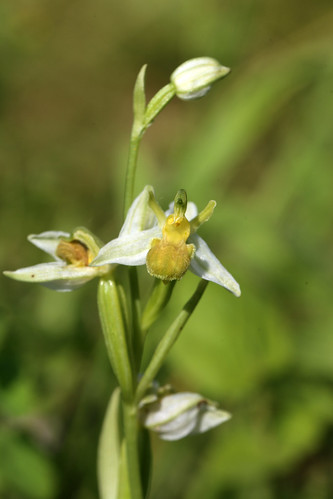 I find a place to park off the road, then walk to the island, passing lines of cars waiting to turn. I was an item of interest with me having a long lens attached to my camera. I dodge between the cars, onto the island and look for a flattened area, and sure enough on the south side, there it was. Or I saw the flattened grass at first, but at the middle was a small green and white spike, glistening in the sunshine.
I find a place to park off the road, then walk to the island, passing lines of cars waiting to turn. I was an item of interest with me having a long lens attached to my camera. I dodge between the cars, onto the island and look for a flattened area, and sure enough on the south side, there it was. Or I saw the flattened grass at first, but at the middle was a small green and white spike, glistening in the sunshine.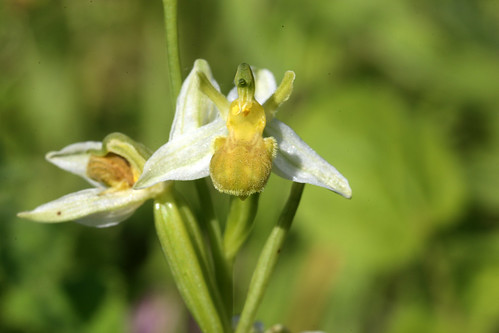 It was said by my dead old Dad many years ago, that flies only feed on rotten meat. This was as Mum and myself were always bitten to buggery by various insects during our holidays in Wales and Scotland. Mosquitoes, gnats, flies, bees, wasps and other such flying, buzzing wee beasties would come and feast, mainly on our sweet East Anglian blood.
It was said by my dead old Dad many years ago, that flies only feed on rotten meat. This was as Mum and myself were always bitten to buggery by various insects during our holidays in Wales and Scotland. Mosquitoes, gnats, flies, bees, wasps and other such flying, buzzing wee beasties would come and feast, mainly on our sweet East Anglian blood.Last year in Scotland, the infamous Scottish midges covered me in bits as I stood on a hill in Glenfinnan, and earlier this year, Danish midges, mozzies and flies ate lots of me whilst I stood on a wooded hillside.
All this went through my mind as I packed on Monday, and I searched the house for Jungle Formula. I found none, but thought to myself, maybe it wouldn't be as bad as that.
I was wrong. It was Denmark all over again.
But before we get to that point, I had to get to the site. Oh yes, the site. I can't mention it by name, but a simple online search of the locations were the little orchids grow will quickly turn it, and other up. But anyway, I promised not to mention it, so, I won't. But so as you know.
The site was north of Great yarmouth, and getting from Mum's to there meant going through Great Yarmouth and dealing with its dreadful traffic jams. Like Lowestoft it has just two bridges over the river, and traffic quickly builds up as rush hour proceeds, so after getting up at half six, I say I'm going to leave straight away, with no breakfast in order to get through the town with no delays.
In fact I was relieved to go, I repeated how I felt, and Mum was still shocked. But, there is no time now for messing around, life is what it is, and I am what I am. And need no excuses.
No traffic in Yarmouth, and most of the traffic on the Acle straight was heading into town, but even driving away there was a solid line of cars, even if we were driving at 50 mph. Once at Acle I only had 15 minutes to go, so I stop at a garage, get breakfast, a snack and a litre of iced coffee, then go on until I find a place to park on the side of the road.
It was seven, and I had two and a half hours to kill.
I eat, drink, and listen to the radio and watch the traffic go by.
 I sit there watching the rain clouds roll in, then drop ever-increasing amounts of rain on the car. Not what was forecast at all.
I sit there watching the rain clouds roll in, then drop ever-increasing amounts of rain on the car. Not what was forecast at all.At quarter to nine I drive the last few miles to the meeting point, which was down a long dead end lane and then park in a farmyard. Rain continued to fall, and the light was awful. Oh dear, and was I in the right place?
When a second car arrived, I knew I was. The driver asked, are you here for the orchids? Yes I was.
As a third car arrived, a bloke came out from one of the barns and shook our hands, welcome, he said. Would you like a brew? We would.
So we go into the warehouse, all full of dangerous looking knives and machetes, and all the other stuff needed to keep the reserve open and accessible for the people who work there. We have a brew, chat and once the final guy turned up on his bike, we put wellies on and set off out into the rain and the countryside.
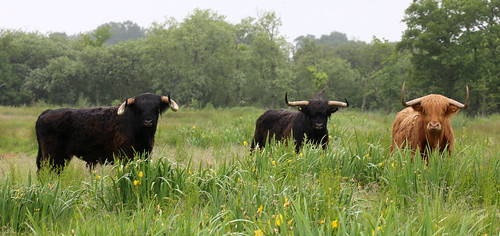 We walked over farmland, past casually interested highland cattle, through a gate and onto the fen.
We walked over farmland, past casually interested highland cattle, through a gate and onto the fen.I know now, that fen is alkali and a bog, acidic. Who knew?
The fen is a mat of plants and centuries of compressed dead vegetation floating on fresh water, the mat is several feet thick, and so when you walk over it, it bounces. No firm ground here, just bouncing, and when you stood still, water seeped up. Water was still falling from the clouds too. But there was brightness, and hope.
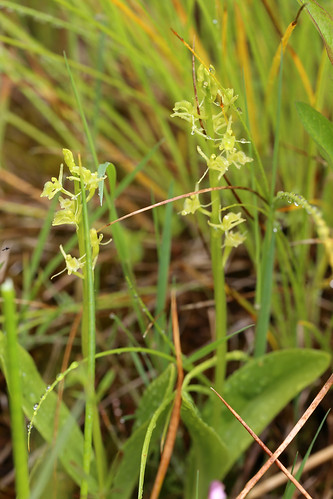 And there was insects. We stopped to put on repellant, but little did I know that the buggers were already biting through my t short on my back, and only later would I discover the dozens of bites when they started to itch.
And there was insects. We stopped to put on repellant, but little did I know that the buggers were already biting through my t short on my back, and only later would I discover the dozens of bites when they started to itch. As we walked, our guide pointed out so many different rare wild plants and flowers, but soon we came to the object of us being there; the Fen Orchid. It is a small, green plant that you can very easily miss, as it grows among taller vegetation, and is green. The background vegetation is also green. Get the picture?
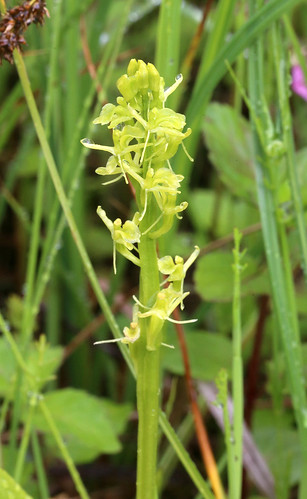 We search for more, and indeed find many more spikes, some bigger than others, and easier to find and photograph.
We search for more, and indeed find many more spikes, some bigger than others, and easier to find and photograph. The rain had stopped, so we began to enjoy the yomp across the fen; fus us orchidists, there were Early Marsh and Southern Marsh orchids everywhere, and hybrids of the two, of course, as well as ever more exotic and rare plants, flowers and grasses. I took many pictures and our guide sent us a list of what we saw, but I have to marry the two!
The rain had stopped, so we began to enjoy the yomp across the fen; fus us orchidists, there were Early Marsh and Southern Marsh orchids everywhere, and hybrids of the two, of course, as well as ever more exotic and rare plants, flowers and grasses. I took many pictures and our guide sent us a list of what we saw, but I have to marry the two! With three metres to go before we left the fen, I discovered one of the "holes", gaps between the tussocks and sank knee deep in mud. I was stuck, but the guide came, told me to pull my foot out and he yanked on the boot to free it, allowing me to put it back on and get to dry land!
With three metres to go before we left the fen, I discovered one of the "holes", gaps between the tussocks and sank knee deep in mud. I was stuck, but the guide came, told me to pull my foot out and he yanked on the boot to free it, allowing me to put it back on and get to dry land!We see two Marsh Harriers, flying low over the fen looking for food. A cuckoo flies past, calling all the while, even perching in a nearby tree, but conditions not good enough to get a shot. One of te other snappers is a twitcher, so keeps us all updated with the calls of birds we hear, one of which he assured us was a Grasshopper Warbler.
All interesting stuff.
We walked over the short stretch of farmland, disturbing a barn owl from its nest in an outbuilding, we stood and watched as it lazily flew away over the fields to the woods in the distance. It had not made a sound.
We go over a floating walkway to see some really rare stuff, tiny plants that eek out a living in the clear, clean water below the fen. Fur us as we walked off the walkway was the danger that the tussocks were the only safe places, so we have to walk from one to the other.
Finally, we walk back onto dry land again, walking gown a lane between two ditches, and in the hedgerow, we could see the unmistakable shape of a swallowtail butterfly. As we walk towards it and angle to get shots, it flies away. We saw just one others, flying high over the trees well out of reach of the camera.
It was quarter to one, and we were back at the barn, so we change out of the boots, bid the guide goodbye, and go back to our cars, so I plan the drive to the next location; Strumpshaw Fen, a public nature reserve, which should mean I see a Swallowtail.
It was half an hour's drive through Brundall to the reserve, and find a place to park on the side of the road, go to the reception, pay my entrance fee, and ask; been any Swallowtails? Not for a couple of hours, I was told. No surprise really as the weather was still dull and grey, a keen breeze was blowing again, and children were being herded to cross back over the railway to a waiting bus. Twitchers and butterfly chases said silent thanks as peace descended onto the reserve again.
I got talking to a bloke, and he took me to the meadow, and said stay here to see the Swallowtails. So I did, and saw none in two hours.
I did see hundreds more march orchids, along with Norfolk Hawkers and Four Spotted Chasers, which I tried to snap as they flew.
I did manage a half decent shot of the Hawker in flight, then one landed near me, allowing me to use the big boy lens to snap it.
 I had been up on my feet for nearly eight hours, there was no sign of the Swallowtail, and the light wasn't improving. I decide to leave.
I had been up on my feet for nearly eight hours, there was no sign of the Swallowtail, and the light wasn't improving. I decide to leave.I hear the sound of an approaching train, line up the camera and was rewarded with the DRS short set hammering past towards Great yarmouth or Lowestoft. A bonus.
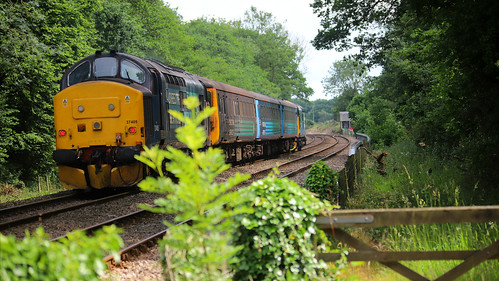 Earlier that month, we had found ourselves travelling up to Essex for a rendezvous in a pub car park:
Earlier that month, we had found ourselves travelling up to Essex for a rendezvous in a pub car park:A huge day of stuff.
I mean huge,
Think of the biggest thing you can think of.
Bigger even than that!
But the biggest part, maybe, I can't tell you about as it is embargoed.
Yes, you read that right.
I received a message to be at a certain car park in a certain town at a certain time. This meant rearranging plans we had just made for the day, which now would have to accommodate a two hour drive north, an hour's stay, then somehow meld in with the original plans to go to London.
The meeting was maybe the only chance to see something in the UK, so not be be passed over.
Anyway, we were up at ready for eight, I thought that maybe we might find some churches there to explore. So getting to the area early seemed like a good idea.
Anyway, with traffic quite light up the M20, the sun trying to break through the light cloud, it seemed to be a great day coming together. We cruised through the Dartford Tunnel, into Essex and round until the right exit, then north for half an hour, before turning off the main road down some lovely quiet country lanes.
We didn't have much luck with churches, with the ones we tried were locked fast, and most unwelcoming, no matter how attractive the village is, not pleasant at all.
So we go to the meeting point, were people of a certain age and with a certain interest are gathering. A local gentleman has a list of names and is ticking them off, so that just after 11 we move off.
We were lead down a lane, along a hedge, across another field, over a ditch, along another field and then to a overgrown part of the field, and in the middle were many small reddy spikes, each one like a partly unrolled ribbon. There were Greater Tongue Orchids, and somehow, they had pitched up here. No one can say for sure how they came to be here, but the colony is likely to be two decades old due to the size and number of the spikes, and had been discovered by chance the year before.
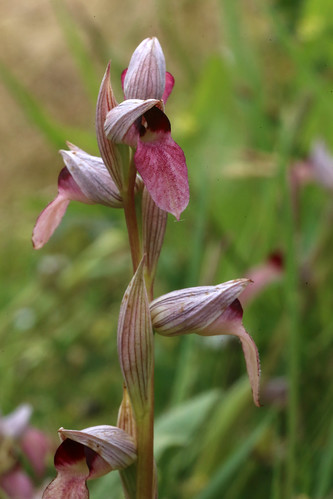 In truth, once you have seen and photographed one, they looked pretty much the same, but this species, pne which grows mostly in warmer Mediterranean locals, were here, happy as larry, though not as large as seen in France and Spain, but happy enough in Essex to grow and thrive over several generations.
In truth, once you have seen and photographed one, they looked pretty much the same, but this species, pne which grows mostly in warmer Mediterranean locals, were here, happy as larry, though not as large as seen in France and Spain, but happy enough in Essex to grow and thrive over several generations.An hour later we return, Jools have been drinking coffee in the pub whose car park we used. I have a soft drink before we drive back south to London, the intention being that we would find a fine country pub and eat and drink well in the beer garden. I had in my mind's eye the sort of whitewashed timber framed former coaching inn I would prefer, and that it would have a fine selection of ales to choose from.

No comments:
Post a Comment